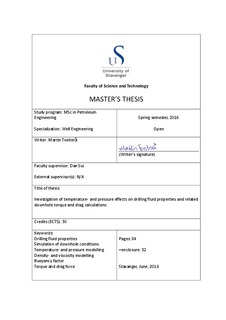| dc.description.abstract | Increasing temperature and pressure with depth, affects the properties of drilling fluid. The effect of temperature and pressure on the density and viscosity of drilling fluid is of great importance. This is because, among several reasons, it affects the calculation of downhole pressure and the buoyancy factor for the well. Correct pressure estimation, could pose a great concern regarding well integrity. The buoyancy factor would affect the effective weight of the drillstring, which again would be a property of calculation of torque and drag force in a well.
In the work of evaluating the downhole temperature and pressure, modelling is important. In this thesis, models to do so, is investigated. Simulation of downhole conditions have been carried out. Sensitivity analysis, regarding the most critical parameters of the temperature, is performed. The effect of different sized pipes and equipment’s on the temperature and pressure will be investigated. If the result of changed size of a pipe is higher or lower temperature and/or pressure, this would again affect the density and viscosity of drilling fluid.
Torque and drag force is, as mentioned, connected to the calculation of the buoyancy factor. Torque and drag control is an important aspect of well design. In order to be able to drill as far as desired, drag force and torque loss needs to be properly handled. In the evaluation of torque and drag force, it is differentiated between straight inclined wellbore and curved wellbore. Conditions for determining whether the wellbore is either straight inclined or curved, will be implemented in the torque and drag force calculations. In addition, the effect of combined motion on the torque and drag force, will be investigated. Findings regarding the combined motion, indicates that torque and drag force is affected by combined motion. Regarding the drag force, it is observed, that generally, the drag force is lower for the cases with constant buoyancy factor throughout the well, than for the cases with varying buoyancy factor with depth. For the torque, it was observed, that generally, the torque for cases including lowering, hoisting and static conditions of the drillstring, the torque in the well is lowered when a constant buoyancy factor is applied. | nb_NO |

